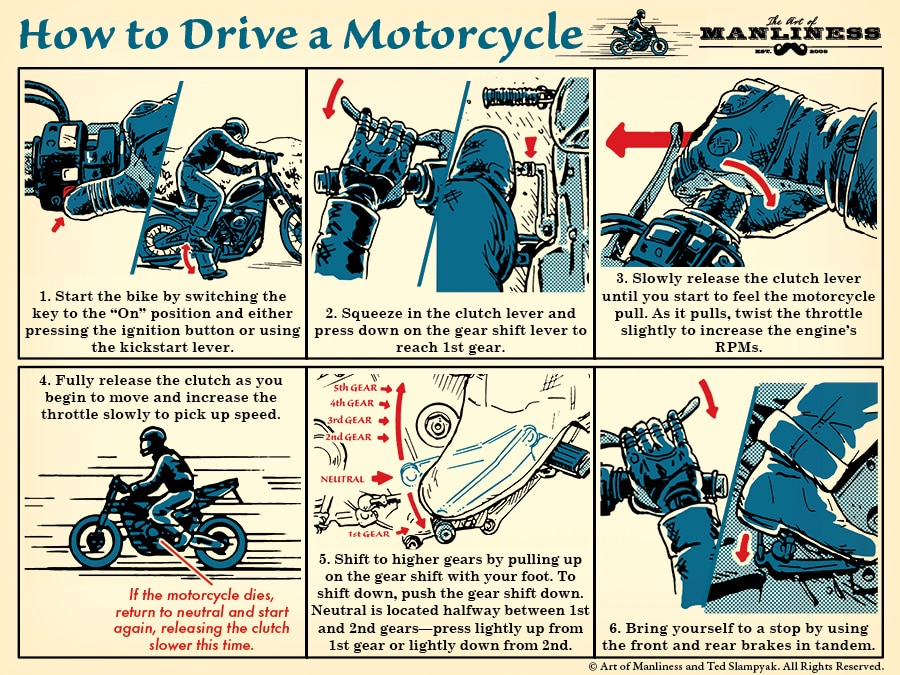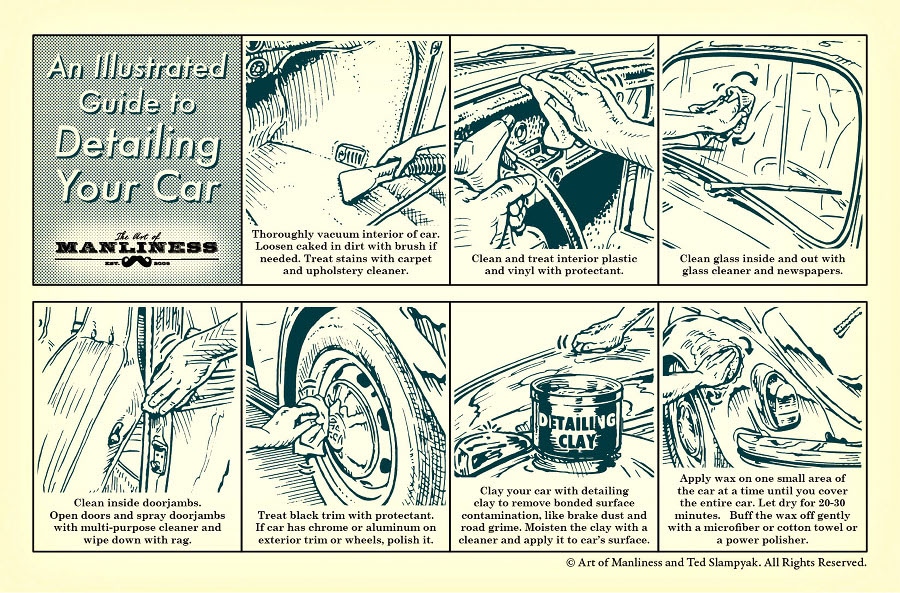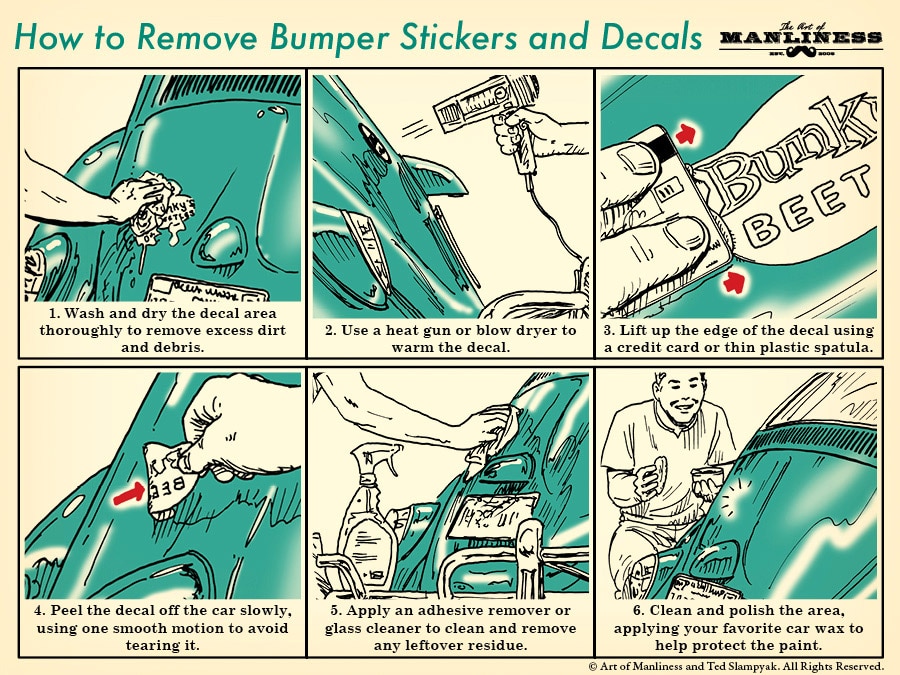
I can still remember the day I learned how to drive a stick shift. My dad and I were looking for a car for my sixteenth birthday. I had my eye on a red Isuzu Hombre (that’s right, the make of my first car was the Spanish word for “Man”). Only problem? It had a manual transmission, and I only knew how to drive an automatic.
“Not a problem,” my dad said.
He got the keys from the salesman and we went for a test drive. My dad pulled into a cemetery that had a big, empty road that winded throughout the grounds. He stopped the car, turned it off, and got out.
“Okay, Brett-os. Your turn.”
So began my initiation into the high art of stick shift driving.
I stalled out the first time I tried to get the car started. Then the second time. And then a third time. My dad just sat there and chuckled silently to himself, while offering some fatherly pointers. Finally, on the fourth attempt, I got the little truck going. When my dad saw that I could stop and start the Hombre consistently and shift gears without grinding the clutch, he gave the okay for me to get the truck. And off I went, lurching into my new freedom.
It’s been over a decade since I first learned how to drive stick, and I’m still cruising America’s highways and byways the very same way. But the number of my gear-shifting brethren are few; after Oldsmobile introduced the first automatic transmission in 1940, the number of manual transmission vehicles on the road took a steep dive, and for the last few years have represented only about 4% of annual auto sales in the US. (Interestingly, in the first quarter of 2012, sales of manuals jumped up 3%, perhaps signaling a small comeback). While our numbers may be few, there are several reasons you should consider joining our ranks.
Why You Should Learn How to Drive Stick
You never know when you’ll need to know how. Has your friend become inebriated and you need to drive him and his old Ford “three on tree” Bronco home? Do you need to borrow a friend’s car, and the only one available has a manual transmission? What about renting a car while abroad? Manual transmission cars are much more common internationally than in the US, so automatics are not always available, and if they are, are much more expensive.
Knowing how to drive stick means you’ll never be caught flat, clutch-shy-footed, in a pinch. A man who knows how to drive a standard transmission car can also easily drive an automatic, but the reverse isn’t true. Better to know it and not need it, than need it and not know it.
Manual transmission cars are generally less expensive than automatics. Because very few people today know how to drive a stick shift, the demand for them is low. This can be annoying if you’re looking for a specific model of car with a manual transmission and it isn’t offered. But the upside is that manual transmission vehicles are often priced lower than their automatic counterparts, and the lackluster demand for them can be a bargaining chip when you’re buying used. They tend to sit on the lot longer, so tell the salesman you’d be more than happy to take that lonely manual off their hands if they’ll drop the price some more.
So you don’t hop into a “borrowed” getaway car you can’t drive. Because a manual transmission can act as a possible thief deterrent.
Manual transmission vehicles generally get better gas mileage. Not only will knowing how to drive a standard save you money when you purchase your car, it can also save you money for years after, as they typically get better gas mileage than their automatic cousins. While it’s true that recent automatics have closed this gap, and a few models can even beat their manual counterparts, manuals still have the edge; Consumer Reports found that, on average, a stick shift can improve gas mileage by 2 to 5 miles per gallon. With gas prices as high as they are, every little bit of savings helps.
You can sometimes push start a manual transmission car with a dead battery. If you have a dead battery, but no jumper cables, you can often get cars with a manual transmission, particularly older models, going with the good ol’ push start.
Some really cool cars only come with a manual transmission. If you ever decide to buy a vintage sports car and fix it up, knowing how to drive stick will greatly expand your selection of vehicles. And if you ever win a contest where the prize is an Aston Martin V12 Vantage or a Ford Shelby GT500, you better know how to drive stick. Those cars only come with manual transmissions, and there are countless other high-end and luxury sports cars that are standard transmission only too. Why? Because guys who are willing to drop some serious coin on such vehicles tend to want the full driving experience, which is to say…
Driving stick is simply more fun! If you’ve only driven with an automatic transmission your entire life, you don’t know the fun you’ve been missing. Driving an automatic feels passive and artificial – like you’re merely pointing or steering the car instead of controlling it. With a manual, you actually feel like you’re part of the car, and you’re attuned to its vibrations and noises. Plus, manual transmissions are proactive instead of reactive – you get into the gear you need instead of waiting for the automatic tranny to hunt for the right one.
Sure, this fun factor is dampened if you do most of your driving in stop-and-go traffic, or in a city with ginormous hills. But once they go manual, a lot of guys never go back, because automatics seem like a snoozefest in comparison.
How to Drive Stick: The Basics
First: Get Familiar With Your Cockpit
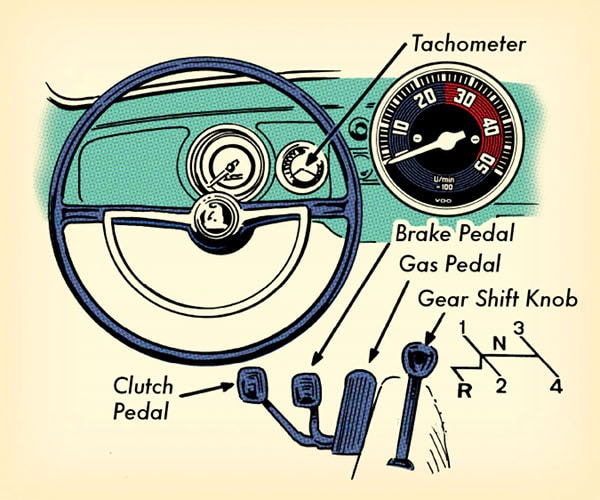
The pedals: clutch, brake, gas. The clutch pedal – absent on your automatic transmission car — is the pedal on the far left. You press the clutch pedal when you shift gears up or down. More on shifting in a minute.
The brake is the pedal in the middle; it’s used for, well, braking.
The pedal on the far right is the gas. Works just like your gas pedal on your automatic transmission.
One of the things that throws people off when driving a stick shift for the first time is the addition of that clutch pedal because you now have to use BOTH feet when driving — not just your right foot. You’ll be using your left foot to press the clutch and your right foot to press the brake and gas pedal.
The gear shifter. Your gear shifter does just that — it shifts the gears on your transmission. Most modern manual transmission vehicles come with six gears: first through fifth gears, and then reverse gear. On the knob of the gear shift you’ll find a diagram that shows what position the shifter needs to be in in order to engage each gear.
The tachometer. The tachometer is a gauge on your dashboard that shows you how many revolutions per minute your engine’s crank shaft is going. When you begin driving a stick shift, the tachometer is a good way to help you determine when you should shift up or down. Generally, you should shift gears up when the tachometer is around “3” or 3,000 RPMs; shift down when the tachometer is around “1” or 1,000 RPMs. After some experience with driving a stick shift, you’ll be able to figure out when to shift by the way your engine sounds and “feels.” More on that below.
Practice Shifting Gears and Pressing the Clutch and Gas With Car Turned Off
A little note before getting into the mechanics of driving stick: I highly recommend that you practice what we’re about to explain with the car turned off and the parking brake engaged. It gives you a chance to get a feel for how the gears engage and disengage and how much give or resistance the clutch has. It also allows you to get comfortable with the general body mechanics of moving the gear shifter and pressing the pedals with both feet versus just one. So after you read the instructions and before you turn on the car, practice going through the motions of shifting.
Getting the Car Going
Probably the hardest and most intimidating part of driving a stick shift is actually getting the car going in first gear. It takes a while to figure out how much you need to press down on the gas and how slowly you need to disengage the clutch for the gears in your car to catch and get moving. To prevent any frustration and self-inflicted violence, accept from the outset that you’re going to stall the car. It’s okay. It’s all part of the initiation into the Brotherhood of the Manual Transmission. The good news, though, is once you get the car moving, shifting gears is super easy.
Let’s get this car rolling.
Practice in an empty parking lot. You’re going to stall and lurch the car, so practice where there isn’t any traffic and where you have a flat surface. Empty parking lots are the ideal stick shift practice venue. It’s also a good idea to have somebody in the passenger seat who knows how to drive manual so they can provide pointers.
Press in the clutch and brake pedal, and start the car. To start a manual transmission car, you’ll always need to press the clutch while you turn the ignition switch. While you don’t need to have your foot on the brake to start the car (like you do with an automatic transmission), it’s a good habit to keep.
With the clutch pedal pushed down with your left foot, and your right foot pressed on the brake, turn the car on.
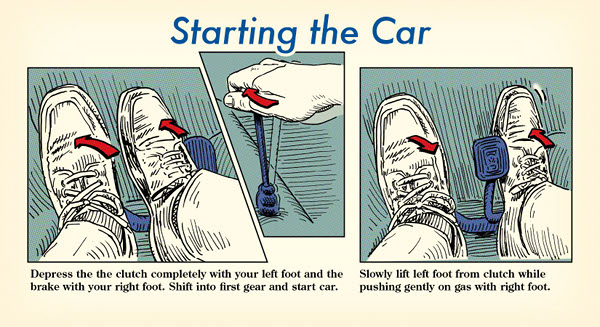
Put the car in 1st gear. If it isn’t already, push the gear shifter into 1st gear. If there’s only one thing you get from what I’m about to explain, let it be this: never shift gears without fully depressing the clutch pedal. Failing to do so while the car is on will result in a horrific grinding sound and you making regular trips (and payments) to the transmission shop. So make sure your foot is still pressing the clutch pedal all the way down before shifting into 1st gear.
To put the car into 1st gear, use your right hand to move the gear shifter up and to the left.
Make sure the gear is fully engaged. How do you know when it’s fully engaged? You’ll be able to feel it as well as see it — the gear shifter should stay in place when you remove your hand from the gear knob.
Keep the clutch pedal and brake pushed down. Don’t take your left foot off the clutch yet or else you’ll stall out. Keep the brake depressed as well.
Move your right foot off the brake and onto the gas pedal. At the same time, start to release the clutch with your left foot. This is the tricky part when you’re first learning. Take your right foot off the brake, move it onto the gas pedal, and start pressing it…while at the same time slowly letting up on the clutch pedal with your left foot. You don’t want to stop pressing on the gas with your right foot while you do this or else you’ll stall. Keep light pressure on the gas pedal with your right foot so that the tachometer stays around 1,500-2,000 RPM while you’re letting up on the clutch with your left foot. If all goes well, you should begin to feel the gears “bite” or take hold of the spinning engine and you’ll start slowly moving forward. When you’re rolling at a steady clip, you can let up on the clutch completely. Congrats! You’ve successfully got a car moving in first gear.
If you stall, begin from the beginning. If you do stall the car, don’t fret. Just start the above process from the beginning.
Come to a stop. To stop, simply press down on the clutch with your left foot and the brake with your right foot at the same time.
Repeat until you can get the car going in first gear without stalling. Keep practicing getting the car going over and over again until you can do it regularly without stalling the car. If you do stall, laugh at yourself, and start the process over again.
Starting the car in first is basically the same process you’ll use when backing up, only the gear shift will be set in reverse. Sometimes if you’re on even a slight decline, you can get going in reverse without needing to press on the gas by simply taking your foot off the clutch.
Find a hill and practice there. Once you’ve mastered starting on a flat surface, find a hill to practice on. Starting from a standstill up a hill requires much more finesse with the clutch and gas pedals. You don’t want your first hill start to be in actual traffic with a car directly behind you. Trying to get your car going without stalling or rolling back into the driver behind you can be nerve-racking for a new manual transmission-er.
Upshifting

As mentioned earlier, once you can get the car moving from a standstill and into 1st gear, you’ve pretty much mastered 90% of stick shift driving. Upshifting into other gears is a breeze. Generally, you’ll want to upshift when the tachometer hits about 3,000 RPMs. It will be different for every car, but it’s a good rule of thumb. If you shift too soon, you’ll feel the car shudder, and you’ll need to downshift to keep it from stalling.
When you’re ready to upshift, just follow this pattern:
- Take your right foot off the gas pedal and press the clutch all the way down with left foot and move gear shifter fully to next gear in one, synchronized motion.
- Release clutch pedal while simultaneously pressing down on the gas pedal with right foot.
- Completely let your left foot off of the clutch pedal once you’re in gear and continue to press the gas.
Downshifting
While you shouldn’t downshift to get your car to come to a stop in normal driving conditions (see below), there is a place for it in your stick shift driving arsenal. Obviously it’s needed when you’re driving in traffic that slows and speeds up as you go along. Downshift as your car slows and the tachometer drops to around 1.
Also, when you’re driving on hazardous roads, particularly on snow and ice, you don’t want to rely on your brakes to slow down lest you slide into the car in front of you. Instead, slow the car down by shifting into lower gears. If the roads are really slick, you’ll probably just want to stay in second gear.
Knowing When to Shift Gears Without Looking at the Tachometer
You’ll probably rely on the tachometer when you first start driving a stick shift to know when to shift gears. But with experience, you’ll be able to do it by how the car sounds and feels. If the engine is making a high pitched noise and it feels like no matter how much gas you give, you’re getting nowhere, then you’re in too low a gear and need to upshift. If the engine is making a low, rumbling noise and is vibrating a lot, you’re in too high of a gear and you need to downshift.
Don’t Ride the Clutch
You’ll want to avoid “riding the clutch.” What that means is avoiding resting your left foot on the clutch pedal when you’re in gear. While the light pressure of your foot resting on the clutch pedal is not enough to disengage the gear completely, it is enough to partially disengage it which causes premature wear and tear on your clutch.
Bottom line: when you’ve successfully shifted into a gear (or neutral), remove your left foot completely from the clutch pedal.
Coming to a Stop
There are two schools of thought on how one should come to a stop when driving a manual transmission car. The first method is to slow the car down by downshifting until you get to second gear and only then applying your brakes. The second method is to press on the clutch and shift the car into neutral, and then remove your foot from the clutch pedal, coasting to a stop using the brake pedal as needed.
While it’s true you can slow your car down by simply downshifting, it does cause a lot of wear and tear on your clutch and transmission. According to Click and Clack, (and this is also the way I learned to do it), it’s easier on your car to use the second method. Shift to neutral and use the brake. When you’re not able to put it in neutral, remember that you need to press in the clutch and the brake at the same time when you come to a stop.
Parking
When you park a manual transmission car, the emergency brake is your friend. You’ll want to set it every time you park your car, whether on a flat or sloping surface. For added safety, leave the car in first gear. If you’re parked on a hill, pointing downhill, put it in reverse. And no matter which direction you’re pointed on a hill, turn your front wheels so that if the car started rolling, it would roll into the sidewalk.
Well that covers the basics. There’s more to understand about driving stick, but you’ll learn most of what remains from experience, as you get attuned to listening to your car. After a while, shifting gears will feel as natural as breathing!
Any other tips for the first-time stick shift driver? Have any funny stories about your stick shift learning experience? Share them with us in the comments!
Tags: Cars


